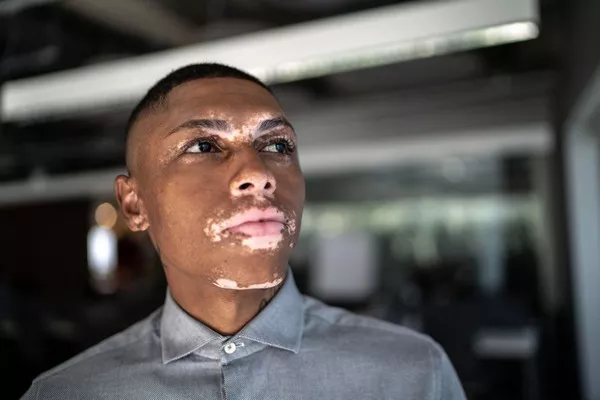Skin discoloration can be a concerning issue for many people. When the skin turns white, it can signal various underlying conditions. This article will explore the causes, symptoms, and potential treatments for white skin discoloration.
Understanding Skin Color
Skin color is determined by melanin, a pigment produced by cells called melanocytes. Melanin protects the skin from harmful UV rays. When there is a decrease in melanin production, skin can appear lighter or white. Understanding the causes of this change can help in seeking appropriate treatment.
Common Causes of White Skin Discoloration
1. Vitiligo
What is Vitiligo? Vitiligo is a skin condition that causes loss of pigmentation. This results in white patches on the skin. The exact cause is not fully understood, but it is believed to be an autoimmune disorder.
Symptoms
- White patches on skin
- Hair can turn white or gray
- Patches may spread over time
Treatment Options While there is no cure, treatments include:
- Topical corticosteroids
- Phototherapy
- Skin camouflage products
2. Tinea Versicolor
What is Tinea Versicolor? Tinea versicolor is a fungal infection that leads to discolored patches on the skin. It often appears lighter than the surrounding skin.
Symptoms
- Small, discolored patches
- Usually affects the back, chest, and arms
- Patches may be more visible after sun exposure
Treatment Options Treatments include:
- Antifungal creams or shampoos
- Oral antifungal medications for severe cases
3. Pityriasis Alba
What is Pityriasis Alba? Pityriasis alba is a common skin condition, especially in children and young adults. It causes light-colored patches, usually on the face and arms.
Symptoms
- Dry, scaly patches
- Often mistaken for eczema
- May be more noticeable in the summer
Treatment Options Most cases resolve on their own. However, moisturizing creams and mild corticosteroids can help reduce dryness and inflammation.
4. Sun Damage
What is Sun Damage? Excessive sun exposure can damage the skin, leading to areas of hypopigmentation, where skin turns lighter.
Symptoms
- Light spots or patches on sun-exposed areas
- Increased risk of sunburn
- Skin may feel dry or rough
Treatment Options Prevention is key. Use sunscreen and protective clothing. Treatments include:
- Topical retinoids
- Chemical peels
- Laser therapy
5. Albinism
What is Albinism? Albinism is a genetic condition where individuals are born without the ability to produce melanin. This leads to very light skin, hair, and eyes.
Symptoms
- Very light skin and hair
- Increased sensitivity to sunlight
- Vision problems
Treatment Options There is no cure for albinism, but management includes:
- Sun protection
- Regular eye exams
- Support for social challenges
Other Causes of Skin Turning White
6. Lichen Sclerosus
What is Lichen Sclerosus? Lichen sclerosus is a chronic skin condition that mainly affects the genital and anal areas. It causes white patches and can lead to thinning of the skin.
Symptoms
- White, shiny patches on the skin
- Itching or discomfort
- Skin may become fragile
Treatment Options Treatments often include:
- Topical steroids
- Regular follow-up with a dermatologist
7. Eczema
What is Eczema? Eczema, or atopic dermatitis, can cause areas of skin to become lighter after healing from inflammation.
Symptoms
- Red, itchy patches
- Skin may appear scaly or dry
- Areas can become lighter after the rash heals
Treatment Options Management includes:
- Moisturizers
- Topical steroids
- Avoiding irritants
8. Hypopigmentation Post-Inflammation
What is Post-Inflammation Hypopigmentation? This occurs after the skin experiences trauma or inflammation, such as cuts, burns, or acne. The affected areas may heal lighter than the surrounding skin.
Symptoms
- Lighter patches where skin was injured
- Color may improve over time
Treatment Options Patience is often key. Options include:
- Sunscreen to protect affected areas
- Topical treatments to enhance pigmentation
When to See a Doctor
It is essential to seek medical advice if you notice:
- Rapid spreading of white patches
- Changes in skin texture
- Accompanied symptoms like itching or discomfort
A dermatologist can help diagnose the condition accurately and recommend appropriate treatments.
Preventive Measures
1. Sun Protection
Using sunscreen with high SPF can help prevent skin damage. Reapply every two hours, especially after swimming or sweating.
2. Healthy Skincare Routine
Moisturizing regularly can improve skin health. Use gentle cleansers and avoid harsh chemicals.
3. Balanced Diet
A diet rich in vitamins and antioxidants can support skin health. Foods high in vitamins A, C, and E are beneficial.
4. Avoiding Skin Irritants
Identify and avoid products that irritate your skin. Patch testing new products can help prevent reactions.
Conclusion
Skin turning white can be caused by various factors, including vitiligo, fungal infections, sun damage, and genetic conditions. Understanding the underlying causes is crucial for effective treatment and management. If you notice changes in your skin, consult a healthcare professional for advice and guidance. Early intervention can lead to better outcomes and improved skin health. Remember to take care of your skin and protect it from harmful environmental factors.
Related topics:

























